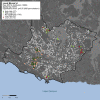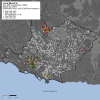Geographic clusters of objectively measured physical activity and the characteristics of their built environment in a Swiss urban area
- PMID: 35196322
- PMCID: PMC8865698
- DOI: 10.1371/journal.pone.0252255
Geographic clusters of objectively measured physical activity and the characteristics of their built environment in a Swiss urban area
Abstract
Introduction: Evidence suggests that the built environment can influence the intensity of physical activity. However, despite the importance of the geographic context, most of the studies do not consider the spatial framework of this association. We aimed to assess individual spatial dependence of objectively measured moderate and vigorous physical activity (MVPA) and describe the characteristics of the built environment among spatial clusters of MVPA.
Methods: Cross-sectional data from the second follow-up (2014-2017) of CoLaus|PsyCoLaus, a longitudinal population-based study of the Lausanne area (Switzerland), was used to objectively measure MVPA using accelerometers. Local Moran's I was used to assess the spatial dependence of MVPA and detect geographic clusters of low and high MVPA. Additionally, the characteristics of the built environment observed in the clusters based on raw MVPA and MVPA adjusted for socioeconomic and demographic factors were compared.
Results: Data from 1,889 participants (median age 63, 55% women) were used. The geographic distribution of MVPA and the characteristics of the built environment among clusters were similar for raw and adjusted MVPA. In the adjusted model, we found a low concentration of individuals within spatial clusters of high MVPA (median: 38.5mins; 3% of the studied population) and low MVPA (median: 10.9 mins; 2% of the studied population). Yet, clear differences were found in both models between clusters regarding the built environment; high MVPA clusters were located in areas where specific compositions of the built environment favor physical activity.
Conclusions: Our results suggest the built environment may influence local spatial patterns of MVPA independently of socioeconomic and demographic factors. Interventions in the built environment should be considered to promote physically active behaviors in urban areas.
Conflict of interest statement
The authors have declared that no competing interests exist.
Figures


Similar articles
-
The contribution of area-level walkability to geographic variation in physical activity: a spatial analysis of 95,837 participants from the 45 and Up Study living in Sydney, Australia.Popul Health Metr. 2017 Oct 3;15(1):38. doi: 10.1186/s12963-017-0149-x. Popul Health Metr. 2017. PMID: 28974226 Free PMC article.
-
Assessing opportunities for physical activity in the built environment of children: interrelation between kernel density and neighborhood scale.Int J Health Geogr. 2015 Dec 22;14:35. doi: 10.1186/s12942-015-0027-3. Int J Health Geogr. 2015. PMID: 26694651 Free PMC article.
-
Association of Perceived Built Environment Attributes with Objectively Measured Physical Activity in Community-Dwelling Ambulatory Patients with Stroke.Int J Environ Res Public Health. 2019 Oct 15;16(20):3908. doi: 10.3390/ijerph16203908. Int J Environ Res Public Health. 2019. PMID: 31618860 Free PMC article.
-
Spatial clustering of physical activity and obesity in relation to built environment factors among older women in three U.S. states.BMC Public Health. 2014 Dec 24;14:1322. doi: 10.1186/1471-2458-14-1322. BMC Public Health. 2014. PMID: 25539978 Free PMC article.
-
Built Environment and Health Behaviors: Deconstructing the Black Box of Interactions-A Review of Reviews.Int J Environ Res Public Health. 2019 Apr 24;16(8):1454. doi: 10.3390/ijerph16081454. Int J Environ Res Public Health. 2019. PMID: 31022911 Free PMC article.
Cited by
-
The "supercompensation" effect of children's lockdown during COVID-19: based on the analysis of changes in physical activity, sleep, and psychology.BMC Public Health. 2024 Jun 6;24(1):1522. doi: 10.1186/s12889-024-19035-2. BMC Public Health. 2024. PMID: 38844937 Free PMC article.
References
-
- WHO. Global action plan on physical activity 2018–2030: more active people for a healthier world. Geneva: World Health Organization; 2018.
-
- WHO. Global recommendations on physical activity for health. Geneva: World Health Organization; 2010. - PubMed
Publication types
MeSH terms
LinkOut - more resources
Full Text Sources

